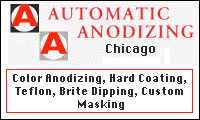
-----
Discoloration of black anodized aluminum
I have a number of machined aluminum plates that are black anodized and are beginning to show a reflective gold or bronze colored discoloration after several months exposure to air. I know something in the air is reacting or catalyzing, because some of the parts have some oil spots on them, and this seems to preserve the original color. Some of the parts are showing this after just sitting on the shelf, while others have done so after assembly while in my customer's facility, so it can't be something specific in the air at either location. Did the finisher fail to properly seal the parts after the color coat? Can these parts be salvaged, even by stripping and re-anodizing? What can I do to prevent this problem in the future?
Steve Myers- Seattle Washington
1996
It does sound like a bad seal … and this can be tested to be sure. Either way, they can probably be stripped & redone.
David A. Kraft- Long Island City, New York
1996
You are correct, there is nothing in the air at either location. The dyes used from anodizer to anodizer can vary in their light fastness (quality), and are purchased according to where they rate on a scale of light fastness. Some anodizers will save a few bucks by purchasing a less expensive dye with a lower light fastness rating. A good black die (such as an MLW type) will have a light fastness rating of 7+. If fading is of concern to your end user, and especially if the part has an application that puts it into direct sunlight, then a quick phone call to some local anodizers can get you their specific dye ratings. The nickel seal solution used to seal the dyes onto anodized aluminum is the most important barrier protecting the dye from UV rays, and a phone call will probably not give you a way of gaging how well the baths are maintained from one anodizer to another. Bad nickel sealing will usually have a chalky "smutty" appearance or a sticky residue associated with it. It doesn't sound like you are experiencing a "bad seal" situation.
Remember, any dye will eventually break down and discolor after prolonged exposure to UV rays. The best you can do is find an anodizer that buys both higher quality dyes (with light fastness ratings above 6), and with whom you have never had a bad seal experience. The combination of high light fastness, and good seal should mean 2 years or more of black dyed parts remaining black before discoloration begins.
If you have the time, send out samples for black anodizing to 4 or 5 local anodizers, and then put them out on the roof of your building. Make sure there is nothing in close proximity to any of the samples, which could cast a shadow over some of them, and give you less than accurate results. Go out and check them every couple of months, and you'll see them bleaching/browning-out at all different rates. The one who's part remains black the longest is the one using the best quality die in combination with a well maintained seal tank. The evidence from this test will be indisputable...
Automatic Anodizing
Chicago, Illinois

June 10, 2009
Q, A, or Comment on THIS thread -or- Start a NEW Thread